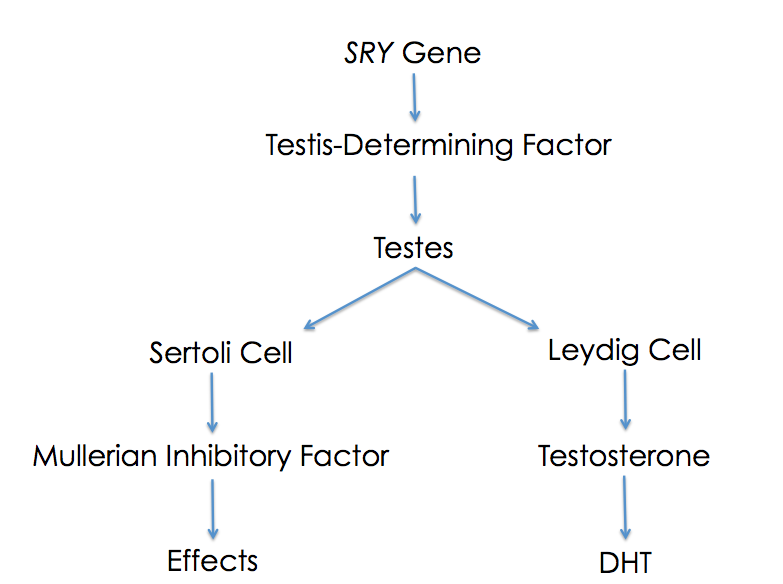WBR0336: Difference between revisions
Jump to navigation
Jump to search
Rim Halaby (talk | contribs) (Created page with "{{WBRQuestion |QuestionAuthor={{Rim}} |ExamType=USMLE Step 1 |MainCategory=Physiology |SubCategory=Genitourinary |MainCategory=Physiology |SubCategory=Genitourinary |MainCateg...") |
Rim Halaby (talk | contribs) No edit summary |
||
| Line 20: | Line 20: | ||
|MainCategory=Physiology | |MainCategory=Physiology | ||
|SubCategory=Genitourinary | |SubCategory=Genitourinary | ||
|Prompt=The image below shows the normal development of male genitalia initiated by the expression of testis-determining factor by | |Prompt=The image below shows the normal development of male genitalia initiated by the expression of testis-determining factor by ''SRY'' gene on the Y chromosome. There is a clear relationship between levels of testosterone and Mullerian inhibitory factor (MIF) or anti-Mullerian hormone (AMH). Which of following statements is most likely true about this process? | ||
[[Image:WBR0336.png|500px]] | [[Image:WBR0336.png|500px]] | ||
|Explanation=Anti-mullerian hormoner (AMH) or mullerian inhibitory factor ( | |Explanation=Anti-mullerian hormoner (AMH) or mullerian inhibitory factor (MIF) is secreted by the immature Sertoli cells. In the neonatal period, AMH levels are elevated and are not inhibited by the action of testosterone because Sertoli cells in the neonatal period lack any receptors for androgens. In converse, when males reach puberty, AMH levels are significantly decreased, suggesting pubertal development of the Sertoli cells. Remarkably, the decrease in AMH levels are seen before the rise of serum testosterone levels is seen in male subjects at puberty. This observation led to the discovery that intratesticular testosterone is the real inhibitor of AMH at puberty. This physiological process is absent in patients with androgen-insensitivity, whereby AMH levels remain elevated by the function of FSH without any inhibitory effects of androgens. | ||
Educational Objective: | Educational Objective: | ||
Revision as of 04:00, 21 November 2013
| Author | [[PageAuthor::Rim Halaby, M.D. [1]]] |
|---|---|
| Exam Type | ExamType::USMLE Step 1 |
| Main Category | MainCategory::Physiology |
| Sub Category | SubCategory::Genitourinary |
| Prompt | [[Prompt::The image below shows the normal development of male genitalia initiated by the expression of testis-determining factor by SRY gene on the Y chromosome. There is a clear relationship between levels of testosterone and Mullerian inhibitory factor (MIF) or anti-Mullerian hormone (AMH). Which of following statements is most likely true about this process? |
| Answer A | AnswerA::Only serum testosterone inhibits anti-Mullerian hormone in the puberty period but not in the neonatal period. |
| Answer A Explanation | AnswerAExp::Serum testosterone does not have a major role in the inhibition of anti-Mullerian hormone. |
| Answer B | AnswerB::Only Serum testosterone inhibits anti-Mullerian hormone in the puberty period and in the neonatal period. |
| Answer B Explanation | AnswerBExp::Serum testosterone does not have a major role in the inhibition of anti-Mullerian hormone. |
| Answer C | AnswerC::Only intratesticular testosterone inhibits anti-Mullerian hormone in the puberty period but not in the neonatal period. |
| Answer C Explanation | AnswerCExp::In the neonatal period, Sertoli cells lack any androgen receptors. Thus, AMH is not inhibited by testosterone in the neonatal period. However, intratesticular testosterone inhibits AMH in the pubertal period. |
| Answer D | AnswerD::Only intratesticular testosterone inhibits anti-Mullerian hormone in the puberty period and in the neonatal period. |
| Answer D Explanation | AnswerDExp::Intratesticular testosterone does not inhibit AMH in the neonatal period. |
| Answer E | AnswerE::Both serum and intratesticular testosterone inhibit anti-Mullerian hormone in the puberty period and in the neonatal period. |
| Answer E Explanation | AnswerEExp::Serum testosterone does not have a major role in the inhibition of anti-Mullerian hormone. AMH is not inhibited by testosterone in the neonatal period. |
| Right Answer | RightAnswer::C |
| Explanation | [[Explanation::Anti-mullerian hormoner (AMH) or mullerian inhibitory factor (MIF) is secreted by the immature Sertoli cells. In the neonatal period, AMH levels are elevated and are not inhibited by the action of testosterone because Sertoli cells in the neonatal period lack any receptors for androgens. In converse, when males reach puberty, AMH levels are significantly decreased, suggesting pubertal development of the Sertoli cells. Remarkably, the decrease in AMH levels are seen before the rise of serum testosterone levels is seen in male subjects at puberty. This observation led to the discovery that intratesticular testosterone is the real inhibitor of AMH at puberty. This physiological process is absent in patients with androgen-insensitivity, whereby AMH levels remain elevated by the function of FSH without any inhibitory effects of androgens.
Educational Objective: Intratesticular testosterone inhibits AMH (or MIF) in the pubertal period but not in the neonatal period. Reference:
Al-Attar L, Noel K, Dutertre M, et al. Hormonal and cellular regulation of Sertoli cell anti-Mullerian hormone production in the postnatal mouse. J Clin Invest. 1997; 100(6):1335-1343. |
| Approved | Approved::No |
| Keyword | WBRKeyword::testosterone, WBRKeyword::intratesticular, WBRKeyword::neonatal, WBRKeyword::neonate, WBRKeyword::period, WBRKeyword::puberty, WBRKeyword::pubertal, WBRKeyword::anti-Mullerian, WBRKeyword::anti, WBRKeyword::Mullerian, WBRKeyword::hormone, WBRKeyword::inhibitory, WBRKeyword::factor, WBRKeyword::Sertoli, WBRKeyword::cells, WBRKeyword::androgen, WBRKeyword::androgens, WBRKeyword::receptor, WBRKeyword::receptors, WBRKeyword::SRY, WBRKeyword::gene, WBRKeyword::testes, WBRKeyword::determining, WBRKeyword::factor, WBRKeyword::insensitive |
| Linked Question | Linked:: |
| Order in Linked Questions | LinkedOrder:: |
